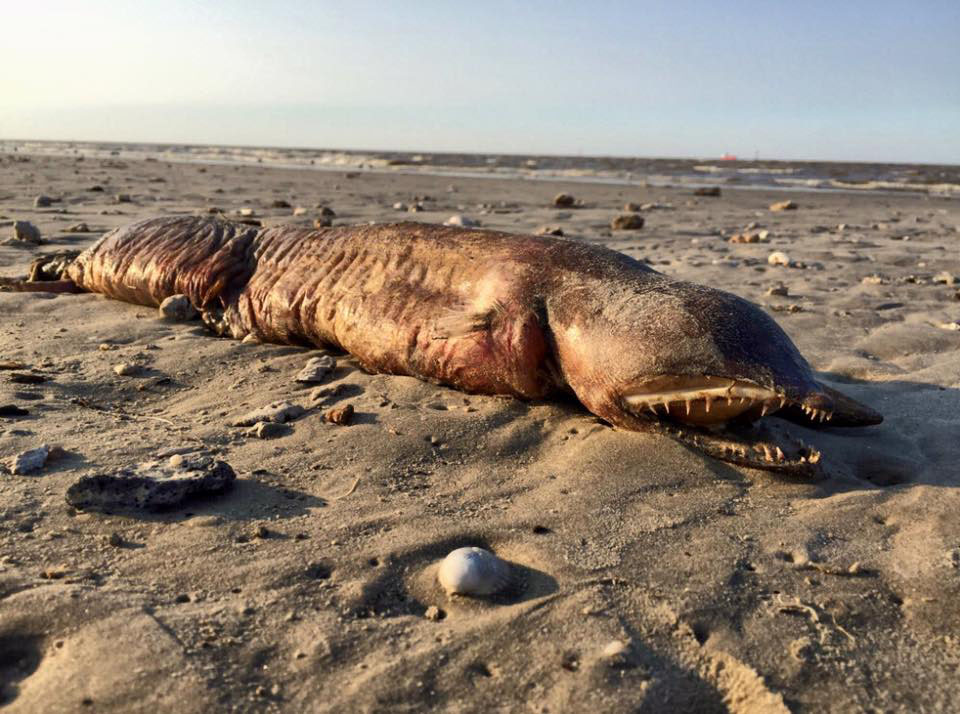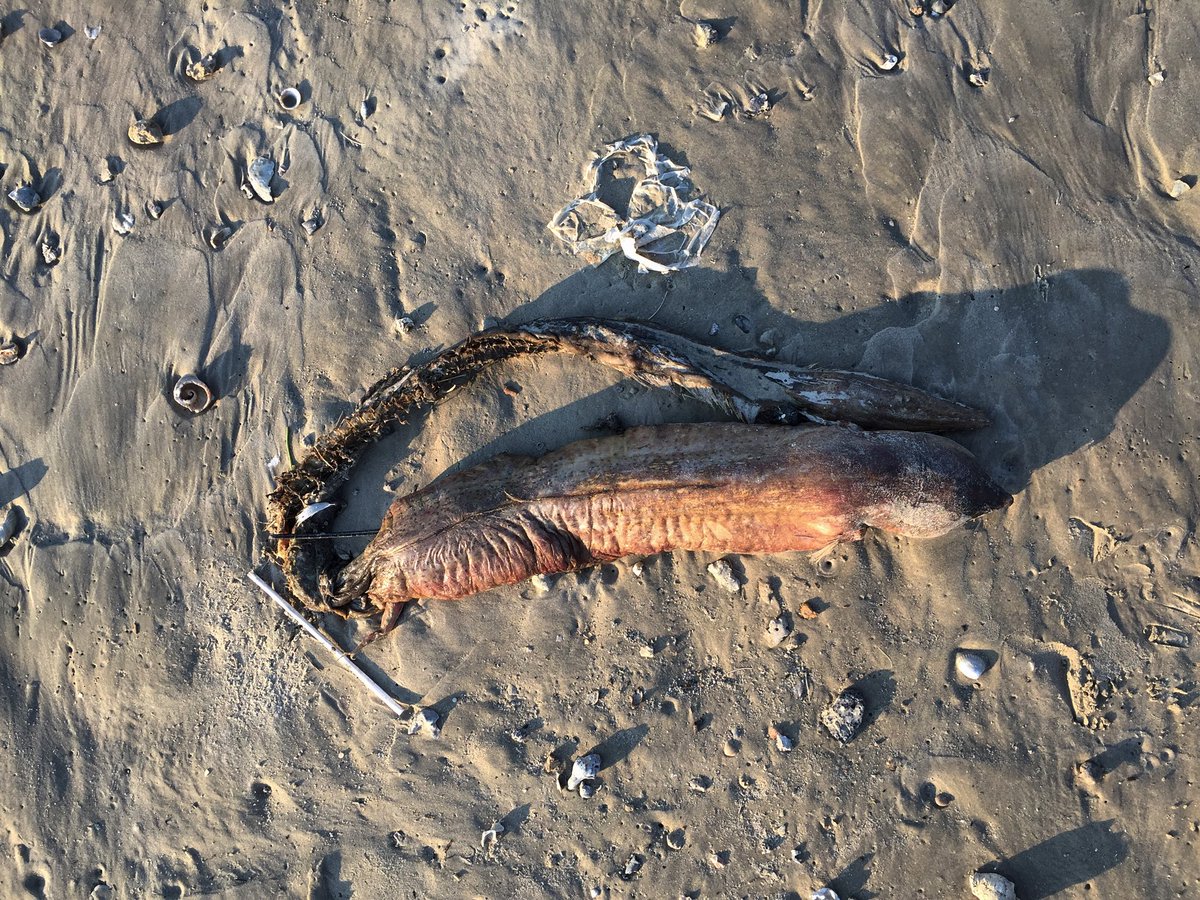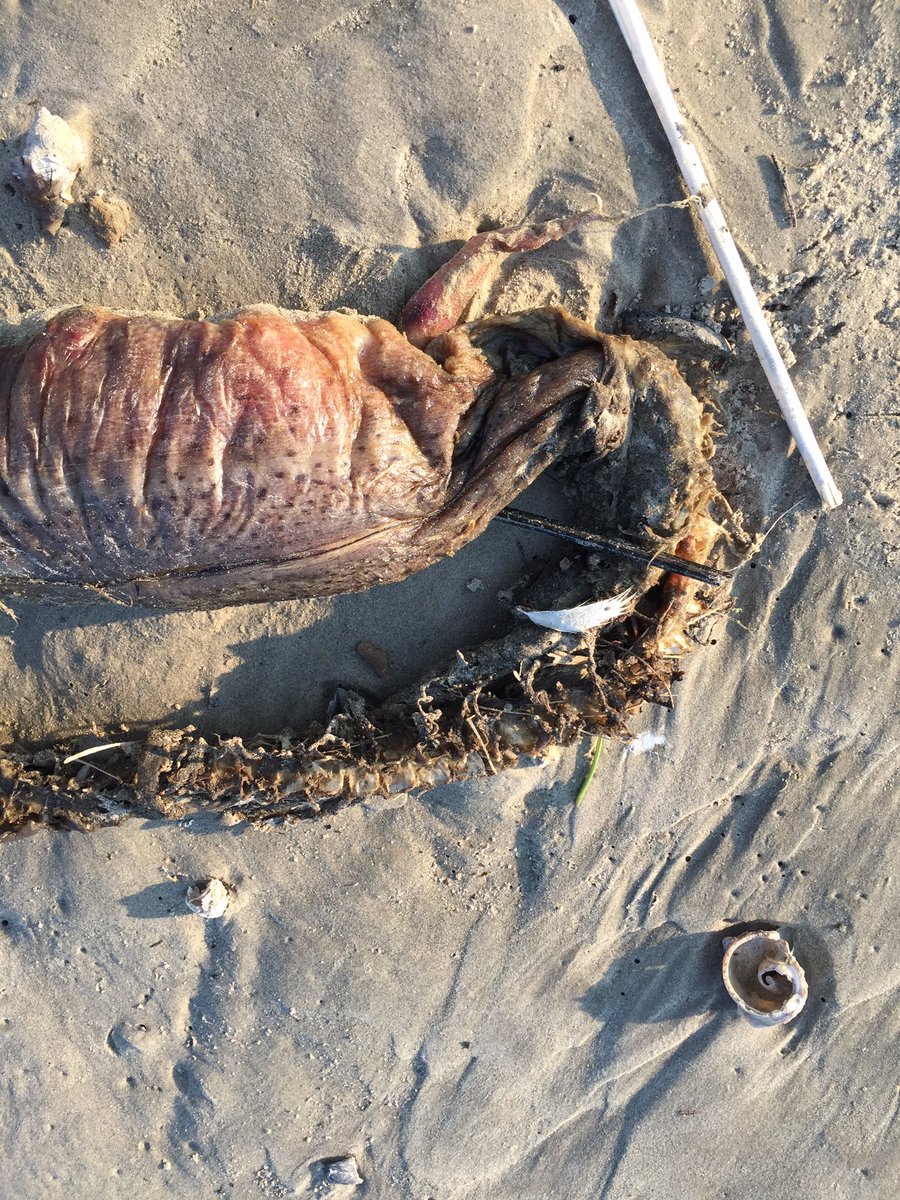2017, September 6: Strange Creature beached by Hurricane
In August and September 2017, the Texas coast in the Gulf of Mexico was hit by the massive Hurricane Harvey which caused unprecedented flooding and damage for both human and animal populations. After the hurricane had quieted down, a group of people from the National Audubon Society arrived in Texas to survey the effects of the hurricane on birds and their habitats.
While the group was inspecting habitats at the local beach near Texas City, they discovered a very strange carcass on the beach. They examined it, turned it over, and examined it more... but no one had a good idea of what they were looking at. One of the people in the group was Preeti Desai, who was the social media director for the National Audubon Society; she took pictures of the body, and later posted the photos to Twitter along with a request for help identifying it. Have a look...

A very odd carcass. [Larger version here]
The above picture was widely displayed by internet news service websites (that largely picked up the story around September 14), but there were three other images posted by Desai of the strange critter as well.


Desai didn't have to wait long for an answer. An eel specialist with the Smithsonian National Museum of Natural History, Dr. Kenneth Tighe, tentatively identified the carcass as an Aplatophis chauliodus, aka the fangtooth snake-eel or "tusky" eel. I say tentatively because the degree of decomposition in the carcass does make it possible that it's a very similar animal, such as a garden or conger eel, as some of these also have large teeth; but it's most likely a fangtooth snake-eel. Fangtooth snake-eel live between 30 and 90 meters deep and spend most of their time hidden in burrows -- so they are not a commonly seen species -- and they do live off the coast of Texas. Tighe explained the carcass' apparent lack of eyes as being due to the condition it was in; the small eyes would have dried out early on in the decomposition, making them hard to see as the rest of the body began to bloat.
And so a scientific curiosity was quickly sorted out... except.
Let The Games Begin!
While news services dutifully reported how the body was found and what Dr. Tighe's identification of it was, by September 15 it was already beginning to be divorced from both it's origin and explanation. A Facebook post by user 'Pictures in History,' which displayed the first image above, gave only the following by way of a description for the photograph: "The decomposing body of a faceless creature that was found on a Texas beach after Hurricane Harvey. Wow!"
While it might be too early yet to worry about it, this exact sort of separation is what usually leads to pictures like this living for years as 'unexplained mysteries' in social networking. I guess only time can tell now... but it sure didn't take long to start!
A Double-Check, Six Years Later...
So, precisely because I was curious about what happened with the pictures above since the story was first reported, in October 2023 I did an image search with the first photo to see what sort of things might turn up... and, honestly, it's not as bad as I thought it would be.
The majority of the references that turned up were the news articles from 2017 themselves, meaning the reporting about the corpse being an eel largely stopped most attempts to present the picture as something else. However, I did find two newer results which are worth a mention, and hopefully don't represent a new development.
In 2020 the Science Ping website posted a story about the matter. Science Ping, as the name implies, specialized in stories that both taught science in layman's terms, and presented a variety of scientific news stories with an entertaining feel to them... which makes how they handled the story above, three years after it was first reported, a bit of a curiosity. Essentially, Science Ping repeatedly uses the word "monster" to describe the body and claims that the corpse had not been identified by anyone at the time of their writing, though some people have guessed it might be an eel... which is not right, nor sounds very scientific.
Science Ping's writer -- identified as "Science Ping," by the way -- claimed their source to be an article from the United Kingdom web site The Sun, so I took a moment to find the older article in The Sun to see what they said. The article they appear to have used for their reference, based on having all the same quotes as Science Ping used in their story, is dated September 13, 2017... and it very clearly appears to be the only article on the matter that Science Ping looked at, given similarities overall. The Sun article actually says the body was identified as a fangtooth snake-eel, but that information is in a picture caption that Science Ping appears to have missed.
So, three years after the story first broke, Science Ping looked up one reference for it and copied what that reference said, poorly, so a whole new audience has a chance to think the body in the picture is still unidentified!
The second questionable appearance of the first photo above is in a YouTube video posted sometime in 2022 by user 'FinnTheFacts,' called "Scariest Things Found (Underwater) Part 2." The picture appears as just one of many odd pictures, that are flashed quickly with a label of "Unknown Creature" above them, as odd music plays in the background.
Given that six years have passed since the strange corpse was first discovered, I'm actually impressed at how few people have tried to re-purpose the photo!
Anomalies -- the Strange & Unexplained, as well as my other website -- Monsters Here & There -- are supported by patrons, people like you! All new Anomalies articles are now posted for my patrons only, along with exclusive content made just for them. You can become a patron for just $1 a month!
|









